沿海三大城市群绿地景观格局与碳排放的时空相关性研究[j]。
摘要
为研究城市绿地景观格局对城市碳排放的影响,以2000 - 2020年夜间照明数据、社会经济发展数据和土地利用遥感数据为基础,以中国-环渤海、长三角三大沿海经济发达地区为研究对象,以珠三角(近100个城市)为研究区,分析了城市碳排放的时空演变特征,以及城市绿地景观格局的影响及其时空变化。利用随机森林模型和Lasso回归模型探讨了10个城市绿地景观格局指数对城市碳排放的影响,并利用时空地理加权回归模型进一步分析了斑块数量、斑块密度、斑块离散度和斑块形状复杂性4个影响较大的因素。探讨城市绿地景观格局对碳排放影响的时空演化结果。研究结果表明:①3个研究区碳排放均呈缓慢增长趋势,环渤海地区碳排放增长较快;研究区碳排放在空间上呈现集聚特征,大部分城市处于“高高”集聚区和“低低”集聚区。研究区碳排放存在空间集聚,以“高高”集聚和“低低”集聚为主。三个研究区陆地平均碳排放呈以经济实力强的城市为核心的全方位分散,总体碳排放水平由中心向周边分散。此外,沿河流和沿海地区,由于港口、工业区和城市的集中,碳排放量更高。②斑块面积、斑块数量和斑块密度与城市碳排放呈显著负相关,表明城市绿地斑块面积、密度和比例越高,对城市碳排放增长的抑制作用越大。相反,斑块形状指数和斑块破碎化指数与城市碳排放呈正相关,说明城市绿地斑块形状复杂度越高,斑块破碎化程度越高,对城市碳排放增长的促进作用越大。此外,斑块聚集指数也与城市碳排放呈显著负相关,表明斑块聚集程度越高,对碳排放增长的抑制作用越强。③绿地景观格局指数与碳排放的相关性存在显著的时空差异,2010年前后变化较大。环渤海地区城市景观格局指数对碳排放的影响保持相对稳定,随时间变化总体呈下降趋势。在长三角地区,城市绿地形状复杂性和分散度对碳排放的影响大于斑块数量和斑块密度因子。相反,珠三角地区城市绿地数量和城市密度指数的影响呈上升趋势。各指标的空间影响变化均表现出回归系数的聚类特征。城市绿地对碳排放的影响在不同地点和时间有很大差异,这表明决策者不能依靠一刀切的方法来进行城市绿地规划。在环渤海地区,更重要的是保持城市绿地与其他土地利用的平衡分布,以保持稳定;在长三角地区,应减少高度碎片化和过于复杂的绿地斑块规划;在珠三角地区,应优先考虑增加城市绿地的数量和分布密度。In order to study the influence of urban green space landscape pattern on urban carbon emissions, nighttime lighting data, socioeconomic development data, and land use remote sensing data from 2000 to 2020 are used as the basis of analysis, and the three major coastal economically developed regions in China-Bohai Rim, Yangtze River Delta (YRD), and Pearl River Delta (PRD) (nearly 100 cities in total) are used as the study area to analyze the spatial and temporal evolution characteristics of urban carbon emissions, as well as the influence of urban green space landscape pattern and its spatial and temporal changes. We also explored the influence of 10 urban green space landscape pattern indices on urban carbon emissions by using the random forest model and the Lasso regression model and further analyzed the four factors (number of patches, density of patches, dispersion of patches, and complexity of the shape of patches) that had a greater influence by using the spatio-temporal geographically weighted regression model, to explore the results of the spatial and temporal evolution of the influence of the urban green space landscape pattern on carbon emissions. The main findings of this study are as follows: ① Carbon emissions in the three study areas showed a slow growth trend, with the Bohai Rim showing a relatively fast growth rate. Carbon emissions were spatially aggregated in the selected study areas, with the majority of cities in the "high and high" agglomeration and the "low and low" agglomeration regions. There was spatial aggregation of carbon emissions in the selected study areas, with the majority of cities in "high and high" agglomeration and "low and low" agglomeration. The land-averaged carbon emissions in the three study areas were dispersed in all directions, with the economically strong cities as the core, and the overall carbon emission level was dispersed from the center to the surroundings. Additionally, along the rivers and coastal areas, carbon emissions were higher due to the concentration of ports, industrial zones, and cities. ② Landscape occupied by patches, number of patches, and density of patches had a significant negative correlation with urban carbon emissions, which indicates that the higher the number, density, and proportion of the landscape occupied by urban green space patches, the more it could hinder the growth of carbon emissions. On the contrary, the shape index and patch fragmentation index had a positive correlation with urban carbon emissions, indicating that the higher the shape complexity of urban green space patches and the higher the fragmentation degree of patches, the more it promoted the growth of urban carbon emissions. In addition, the aggregation index also showed a significant negative correlation with urban carbon emissions, which indicates that the higher the degree of aggregation of patches, the more it could inhibit the growth of carbon emissions. ③ The correlation between the green space landscape pattern index and carbon emissions showed significant spatial and temporal differences, with large changes around 2010. In the Bohai Rim Region, the influence of the urban landscape pattern index on carbon emissions remained relatively stable, and its influence over time generally showed a decline. In the YRD Region, the shape complexity and dispersion of urban green space had a greater impact on carbon emissions than the number of patches and patch density factors. However, on the contrary, in the PRD Region, the impacts of the number of urban green spaces and density index were increasing. In addition, the spatial influence changes on all showed the clustering of regression coefficients. The impact of urban green space on carbon emissions varied greatly across locations and time, suggesting that policy makers cannot rely on a one-size-fits-all approach to urban green space planning. In the Bohai Rim Region, it is more important to balance the distribution of urban green space with other land uses to maintain stability; in the YRD Region, highly fragmented and overly complex green space patch planning should be reduced; and in the PRD Region, priority should be given to increasing the amount and distribution density of urban green space.

 求助内容:
求助内容: 应助结果提醒方式:
应助结果提醒方式:


